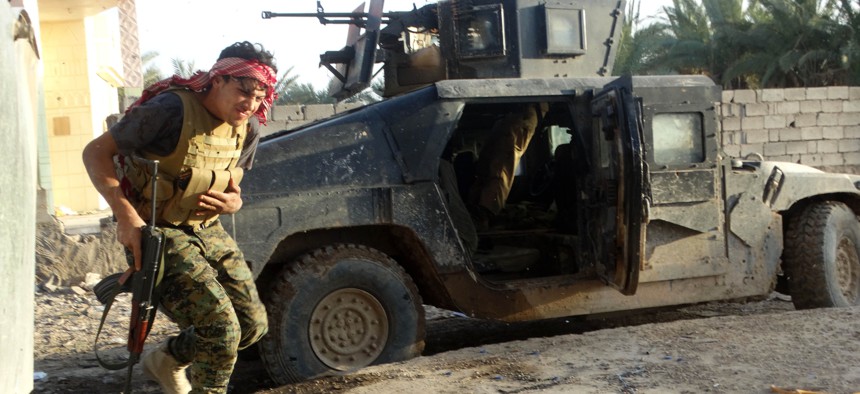
Iraqi security forces joined with Iraqi Army and allied Sunni volunteer tribal fighters, supported by U.S.-led coalition airstrikes, in the assault on Ramadi, Dec. 2, 2015 AP Photo/Osama Sami
The Challenge of Selling ‘Stay the Course’
Obama’s Pentagon photo op was meant to talk tough and say nothing new while convincing the public his plan is working.
It is a rhetorical challenge to make “more of the same” a compelling message, even for an oratorically gifted president. But that’s exactly what the president tried to do when he headed to the Pentagon Monday morning and offered the American public 1,210 words that essentially boiled down to six: stay the course, it is working.
The White House tried last week to make the public see that it felt your pain and heard the nation’s disquiet in an address from the Oval Office after Paris and on the San Bernardino “tragedy, the broader threat of terrorism, and how we can keep our country safe.”
In the aftermath of the ISIS-backed Paris massacre that killed more than 130, Obama’s critics at home and abroad looked to Washington to see whether the bloodshed on the streets of the City of Lights would move this president, who for so long has remained reluctant to intervene in Syria with more decisive U.S. military action.
If they were seeking a change of policy they were not going to find it in Washington. Just after the mid-November attacks the president ruled out ground troops once more while answering a reporter from Agence France Press who asked Obama, “Isn't it time for your strategy to change?” At the Pentagon on Monday, he did not even mention the debate over deploying mass ground troops.
In many ways the public conversation mirrors an internal conversation happening within the administration now since at least 2012. How can the U.S. do more to stop Syria’s civil war or change the balance of power on the ground without creating more problems than military intervention solves? But doing too little has also had a cost. For more than two years, administration officials focused on Syria predicted the current situation: the fear was always that Syria, left as an ungoverned space, would attract extremists who would use the territory as their own Club Med and that they would then use those spaces to plan and launch attacks against Europe and the United States.
“The scripts have been written,” one Obama administration official familiar with Syria policy told me last month just after the Paris attacks. “The scenario that is unfolding has been warned about in writing since 2012.”
The ghost of Iraq and conflicts past, however, has shaped policy debates concerning wars in the present. And the president remained unconvinced that getting involved in the war could be certain to result in anything resembling success, according to administration officials I spoke with. So no action occurred. In the words of one former high-ranking national security official, “it is not that they made a decision you didn’t like, it is that there was no decision.”
Amb. Dennis Ross, in an interview with Defense One in March 2014, said, “It is the fear of failure right now that dominates, and the problem is that it can be so constraining that you never act, and then the consequences of never acting add up and you may face a bigger threat down the road that requires much more of you in less opportune circumstances.”
Now ISIS is that bigger threat. And the president has worked hard to convince Americans that what the U.S. is doing with air strikes, special operations targeting missions, special operations advise and assist missions and covert action run by the CIA is of sufficient to the goal to “degrade and ultimately destroy this barbaric terrorist organization.”
As Obama said in Turkey last month, “In the aftermath of Paris, as I listen to those who suggest something else needs to be done, typically the things they suggest need to be done are things we are already doing.”
The one exception, of course, is ground troops.
“We would see a repetition of what we’ve seen before, which is, if you do not have local populations that are committed to inclusive governance and who are pushing back against ideological extremes, that they resurface -- unless we’re prepared to have a permanent occupation of these countries,” Obama said. “And let’s assume that we were to send 50,000 troops into Syria. What happens when there’s a terrorist attack generated from Yemen? Do we then send more troops into there? Or Libya, perhaps? Or if there’s a terrorist network that’s operating anywhere else -- in North Africa, or in Southeast Asia? So a strategy has to be one that can be sustained.”
Only, as the president is learning, sustainability is not satisfying the American public’s sense that the U.S. is doing enough to fight the “face of evil,” as the president has described ISIS. The administration’s complaints to Congress about delayed confirmations for Defense Department appointees don’t quite cut it, either. Defense Secretary Ash Carter pitched that curveball last week and White House press secretary Josh Earnest restated it in Monday’s press briefing.
So Obama is left asking Americans to trust that a great deal is being done in their name, to describe the special operations raids in greater detail, and to counsel patience for a fight now measured in years, not months, while also making clear he understands the urgency of the mission to “degrade and ultimately destroy” ISIS.
“I think the American people got a sense of that urgency when the president of the United States spoke directly to them on live national television during primetime from the Oval Office eight days ago,” said White House Press Secretary Josh Earnest Monday. “So I think people are keenly aware of the sense of urgency that the president feels about this. But, yes, it’s also important that people understand the progress that's been made thus far.”
And now the president has said it at the Pentagon. If the American people find reassurance in his words, it may turn out the visit really was more than a photo op with generals. It was about finding a way to convince the public that “stay the course” is a match for “degrade and destroy.”




